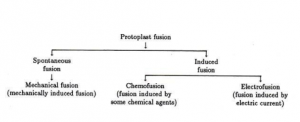II. Protoplast Fusion
Protoplast fusion also called Somatic fusion is a type of genetic modification in plants by which two distinct species of plants are fused together to form a new hybrid plant with the characteristics of both.
There are two methods of Protoplast fusion:
- Spontaneous Fusion
- Induced Fusion
- Spontaneous Fusion
Protoplasts during isolation often fuse spontaneously and this phenomenon is called spontaneous fusion. Simply physical contact is sufficient to bring about the spontaneous fusion among the similar parental protoplasts. During the enzyme treatment for the isolation of protoplasts from adjoining cells fuse through their plasmodesmata to form a multinucleate protoplast. Electronic microscopic studies have shown that as the cell wall are enzymatically degraded, the plasmodesmatal connection between the adjacent cells enlarge due to removal of its constriction and the enlargement of pi fields. Eventually the greater enlargement of plasmodesmata allows the entry of organelles into neighboring cells. Spontaneous fusion is strictly intraspecific and gives rise to homokaryon.
- Induced Fusion
Fusion of freely isolated protoplast from different sources with the help of fusion inducing chemical agents is known as induced fusion. Some of the methods that have been employed are explained below:
i. Chemofusion
In this method protoplasts are fused by using chemical agents like NaNO, Calcium ions or Polyethylene glycol.
a) NaNO3 Treatment
Equal densities of protoplasts from two different sources are mixed and then centrifuged at 100g for 5 minutes to get a dense pellet. This is followed by addition of 4 ml of 5.5% sodium nitrate in 10% sucrose solution to resuspend the protoplast pellet. The suspended protoplasts are kept in water – bath at 35ºC for 5 minutes and again centrifuged at 200 g for 5 minutes. The pellet is once again kept in water bath at 30ºC for 30 minutes. The fusions of protoplast take place at the time of incubation. Finally, the protoplasts are plated in semisolid culture medium. The frequency of fusion is not very high in this method
b) Calcium ions at high ph
Keller and Melchers (1973) studied the effect of high ph and calcium ions on the fusion of tobacco protoplasts. In this method, isolated protoplasts are centrifuged for 3 min at 50xg in a fusion inducing solution of 0.5 M mannitol containing 0.05 M Cacl2.2H20 at a pH of 10.5.The centrifuge tubes containing the protoplasts are then incubated in a water bath at 37ºC for 40-50 min. After this treatment, 20-50 % of the protoplasts are involved in fusion.
c) Polyethylene glycol method
Kao and Michayluk and Wallin developed the PEG method of fusion of protoplasts. This one of the most successful techniques for fusing protoplasts. The protoplasts are suspended in a solution containing high molecular weight PEG, which enhances agglutination and fusion of protoplasts in several species. When sufficient quantities of protoplasts are available, 1ml of the protoplasts suspended in a culture medium are mixed with ml of 28-56% PEG (1500-6000 MW) solution. The tube is then shaken for 5 sec and allowed to settle for 10 min. The protoplasts are then washed several times by the addition of protoplast culture medium to remove PEG. The protoplast preparation is then resuspended in the culture medium. The PEG method has been widely accepted for protoplast fusion because it results in reproducible high frequency heterokaryon formation, low cytotoxicity tomost cell types and the formation of binucleate heterokaryons. PEG induced fusion is non specific and is therefore useful for interspecific,intergeneric or interkingdom fusions.


